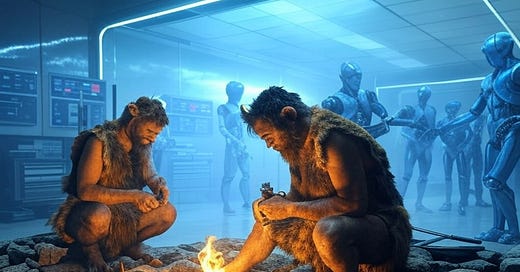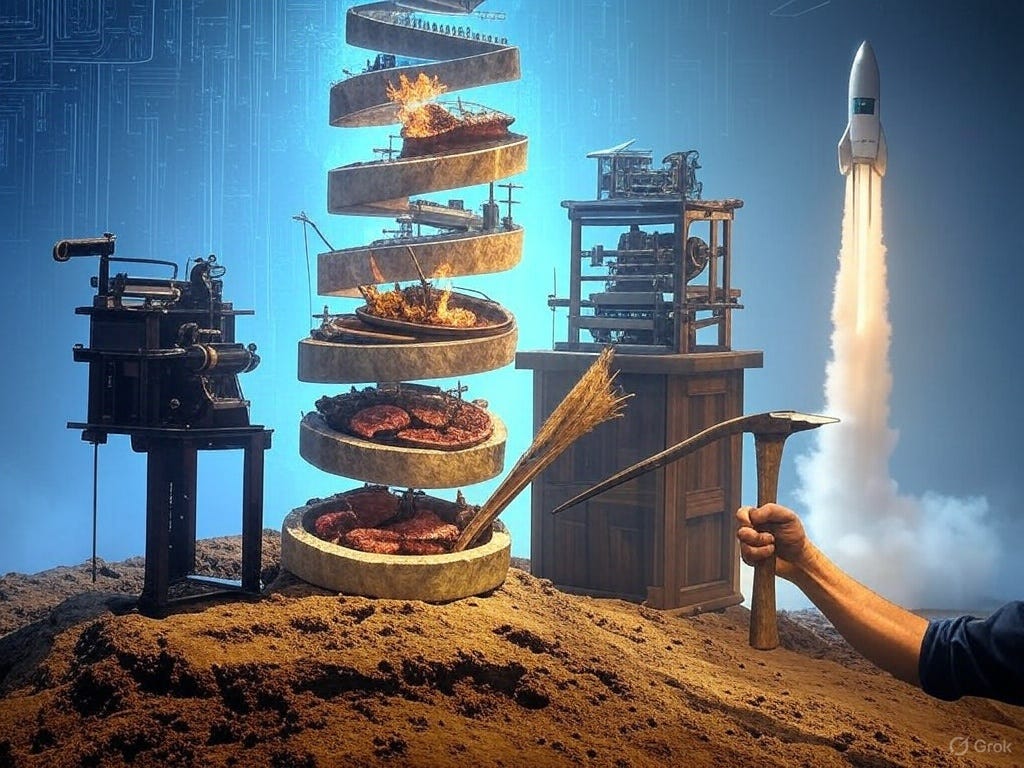TecC 04 - From Stone to Silicon: Technology's Long Arc
From handaxes to hard drives: tracing humanity’s exponential evolution
In the previous episode, we looked at the very first stepping stone of the very origin of technology - very broadly defined, within our technocentric paradigm in this series, as the sum total of all human action that modifies something in the environment around us. Quite literally, this stepping stone was about the very first tool - the handaxe! Let’s now explore, as promised, how we got from there to here, from then to now, from stone to silicon.
From my previous articles and the first-principles approach I’ve taken, it’ll be obvious to you that there is a reason why I am starting the technocentric story with a stone going right back more than tens of thousands of years in time - that stone gave birth to technology, and we celebrate that, well, milestone, by calling it the Stone Age, since it was that consequential.
For those of you now in earnest with me on this technocentric journey, it’ll be gratifying to see that almost every other ‘age’ is based on some other key technology – so we can proclaim that there has indeed been technocentrism before us in history?
Not every one of the key technological innovations has managed to get on the dais of a grand age-title however. I’d now propose a whistle-stop tour of each such vital technological innovation or breakthroughs which should help us trace the evolution of technology from these beginnings to the current reality. There’s a lot more I’d like to talk about, both by way of which breakthroughs to get into in detail, and the extent of that detail. But let me put that aside for a later-day indulgence!
The Primal Catalyst
Another core innovation around the time of crafting the earliest stone tools with far-reaching consequences is the control of fire, which you’ll find me mention elsewhere as well. Using those shiny new handaxes to bring a mighty buffalo to its knees was not enough – the ability to use fire and cook the meat was a significant part of the story of that early breakthrough! This gave the early hominid species huge reserves of protein and energy, freeing themselves from having to spend all their waking hours in pursuit of food, something of the like we can still see in our nearest primate cousins.
So this is the story of the early stone age - of the hunter-gatherer lifestyle that developed, where armed with these, yes, cutting-edge tools,1 the species was able to hunt, cook, and free up a bunch of time. The significant leap in protein consumption is said to have entailed the growth of a bigger brain, providing more reasoning, and thus improved tool-making capability, making it a virtuous circle of technological progress hand in hand with biological evolution.
Roots of Settlement
The next big leap from here also cannot be done justice to in one or two paragraphs, but let’s hope gives us enough food for thought: yes, you guessed it, it’s of course agriculture! In very quick summary, roughly about 10,000 years ago, after the Last Glacial Maximum,2 humans discovered that planting seeds in the soil and tending to them allowed them to grow crops, which promised a way out of the vagaries of the environment leading groups of humans to have to constantly be on the move onto greener pastures - yes, quite literally!
Thus some societies moved from the hunter-gatherer lifestyle, which involved gathering nuts and berries alongside the hunting patterns mentioned, which involved being on the move to find newer areas where such hunting and gathering was easier, eventually to a sedentary life around farms where they could grow crops.3 This also led to the first wave of a set of massive changes in social organization, which I’ll get to in the next episode. But we can see that, for those groups that accomplished this transition, life was never the same again!
Memory Beyond Minds
We then fast-forward to a few thousand years to another fundamental breakthrough. But let’s take a step back in time first to provide perspective.
Human language, by which I mean spoken language, is something we can come equipped to handle as a result of our biological evolution,4 going way back in time before technology. This and related points I emphasize elsewhere when I talk about Artificial Intelligence in general and AI language models in particular, but it’s not hard to imagine what a big enabler language was in the development and especially spread of technology - you could explain to your peers and offspring how a particular tool worked, how to use it to good effect and so on.
But I’d reiterate that spoken language itself here is not ‘technology’, by contrast it’s biology - it’s a genetically enabled capability available to all humans across cultures.
The big technological breakthrough in language came much much later in this grand scheme of things - I’m referring indeed to writing. Without writing we wouldn’t have had this means of communication: you wouldn’t be reading this! But even looking back at the earliest societies that developed writing, it’s not hard again to see how consequential it was. The earliest writing, going back roughly five thousand years – perhaps more practically one or two thousand years later than that, typically developed to keep record of trade and commerce, and was a tool of administration and bureaucracy, from where of course it spread to a great many areas of life, right down to those social media memes your younger sibling loves so much!
Making a Decisive Impact
However, for a few thousand years, it was really ‘handwriting’ - all writing was done by hand, by scribes,5 which were then copied by other scribes, and less voluminously, carved into stone and such lasting forms as in the inscriptions we have all seen. As you can imagine this was laborious and time-consuming, not to mention the monopoly of those scribes who wielded much power - the quill was far mightier than the sword than your pen could ever be!
The next big breakthrough, something that upended this dynamic, was printing, which like writing developed independently in different places at different times, but the most notable one we’ll mention is the Gutenberg press in Europe in the 1400s, with important consequences across Europe6 and later beyond.
At this point it becomes tempting to start to include many other technological breakthroughs, but as mentioned, I intend to get back to them in detailed treatment for each of them in its own right. I’ll only mention three more vital breakthroughs here to complete this rather hurried (for now) whistle-stop tour across technological time.
But as part of appreciating this, let’s look at why each of these were significant breakthroughs.
The control of fire was a key breakthrough in energy technology.7 Agriculture can be seen as a biological enhancement of this. Writing and the printing press are of course vital leaps in information technology, and we’ll have so much to say about this with reference to our own time.
The First Great Acceleration
The next massive breakthrough can be epitomized by the steam engine invented8 by Scotsman James Watt - which is the very foundation of the Industrial Revolution that started in Britain9 in the late 1700s (more on this soon). The core innovation here was energy amplification and thus scalability of production, from what was constrained by the limits of human or animal muscle power to, well practically, only the amount of fuel available. This is why we look at it as bringing about the Industrial Revolution, a massive change from what existed before.
Invisible Forces: From Vast to Tiny
A closely related breakthrough that came after the first Industrial Revolution is electricity, related because it was another step up in our ability to harness energy, as is fairly obvious to most of us. The development of electricity is said to be part of a Second Industrial Revolution that gathered pace around the late 1800s.
And then to what is termed the Third Industrial Revolution - this is the age of computers, of information technology, which started in the 1960s as epitomized by the invention of the transistor - the very foundation of a large number of ‘intelligent’ devices that it’s spawned in the following decades. This is the age most of us reading this have lived through and thus may need far less elaboration than earlier ones.
And finally we’re said to now be undergoing the Fourth Industrial Revolution, but hey, that’s what we’ll eventually get to in this series in some detail, so no spoiler alerts!
What is obvious when we look at the timelines of each such technological era is that there is technological acceleration, where each innovation enables the next at a faster pace, where a bunch of innovations converge to create something much more significant and far-reaching in consequence. The Stone Age lasted thousands and thousands (even millions) of years, the Iron Age hundreds, each industrial age decades, and so on. The key point is this progression is not linear, thanks to compounding impacts, this progression is exponential - and this will become increasing (exponentially?) important in our on-going discourse here.
I hope by now it’s starting to become clearer how this is all connected. The story of the first stone tool might have seemed rather far-removed from our technological and socio-economic reality today, but that’s where it all started. Each new technological innovation removed constraints, expanded the scope of what more was possible, accelerated the pace of such development.
The Twin Engines of Progress
But what I have outlined here, the development of specific tools or artefacts, is itself not the whole story. In our technocentric enquiry, there are a bunch of other enabling factors that play a crucial role in how each step of the above outline of progress came about. Pure technologists, operating in a silo, might satisfy themselves by purely concentrating on the material aspects of the above developments. But that won’t give us the whole story, that won’t paint a wholesome picture of all that happened, and how and why – there’s more to it than this in our story of going from rocks to rockets!
And those complementary aspects we will touch upon in the next episode.
Voice and images generated by AI
I wonder if they show a Swiss Army knife in The Flintstones!
Popularly but not accurately spoken of as the ‘last Ice Age’
Alongside the domestication of wild seeds into cultivable plants, the story of domestication of animals — especially the wolf into the dog, the horse, and the cow — needs told; I hope to get back to it at the first relevant juncture
We’re not genetically programmed to speak or learn any particular language or the other, rather just the ability to learn and use language in general
Medieval influencers?!
Such as the Renaissance and the Protestant Reformation, more on it on another day!
More on energy in a separate series, keep an eye out!
Or more precisely, improved upon, as in the case of many innovations
Is there a link between this and us Brits putting the kettle on before attempting every big problem in life?!





